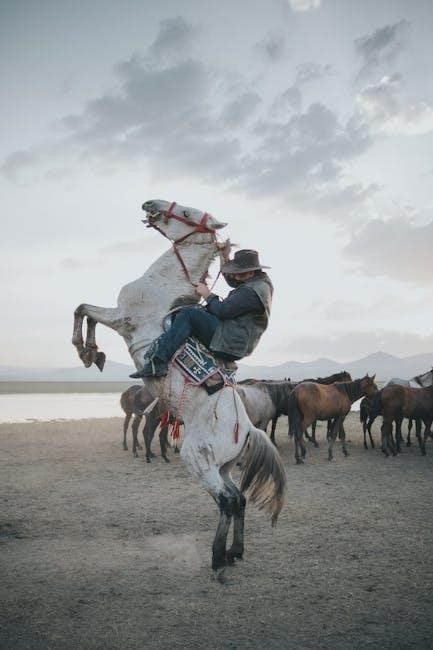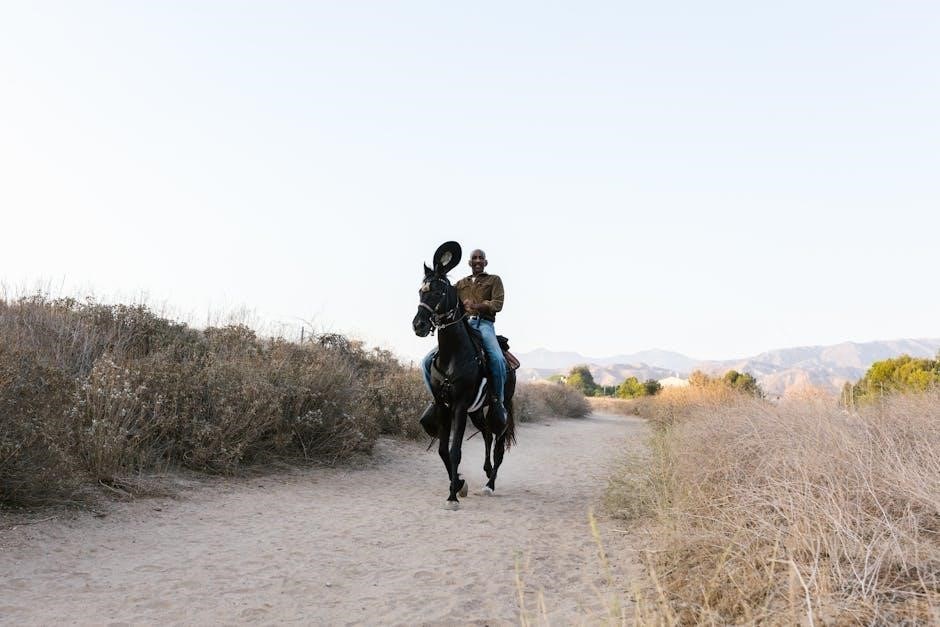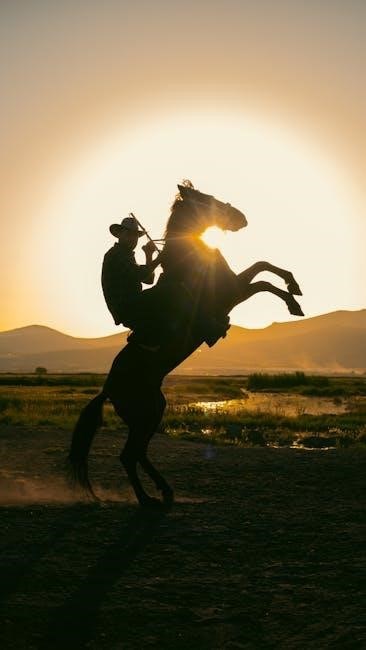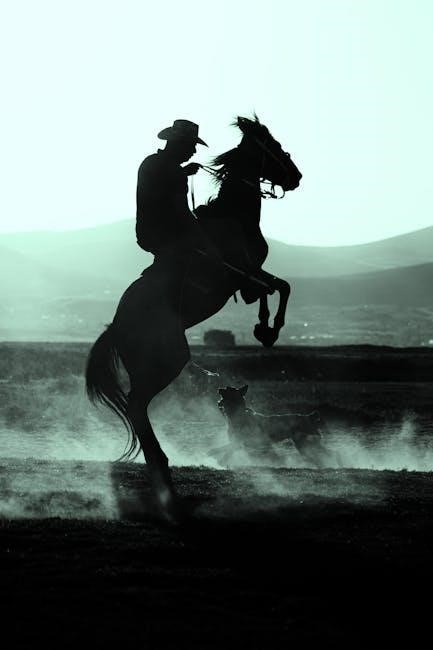western saddle size guide
Western saddle sizes are crucial for both rider comfort and horse well-being. Unlike English saddles, Western saddles have distinct sizing considerations. This guide introduces the basics, focusing on seat size, which ranges from youth to adult sizes.

Why Saddle Size Matters
Saddle size plays a vital role in ensuring a balanced and comfortable riding experience. An ill-fitting saddle can lead to discomfort, hinder performance, and potentially cause long-term health issues for both the horse and the rider, impacting their partnership.
Rider Comfort and Performance
Rider comfort directly influences performance, especially during long rides or demanding activities. A properly sized Western saddle allows for balanced weight distribution, reducing strain on the rider’s back and joints. This enhanced comfort enables better control and communication with the horse, improving overall riding performance. Selecting the correct saddle size is key to preventing fatigue and maintaining focus, leading to a more enjoyable and effective riding experience. Ensure the saddle fits well to avoid discomfort and maximize your riding potential. A well-fitted saddle ensures a secure and stable seat, promoting confidence and skill.
Horse Welfare and Preventing Injury
Horse welfare is paramount, and a correctly sized saddle plays a vital role in preventing injury. An ill-fitting saddle can cause pressure points, leading to soreness, muscle damage, and even long-term skeletal issues. Proper fit ensures even weight distribution, minimizing stress on the horse’s back. Regular checks for saddle fit are essential to adapt to changes in the horse’s body condition. Selecting the right saddle prevents rubs, sores, and discomfort, promoting a healthy and willing partner. By prioritizing proper saddle fit, riders demonstrate responsible horsemanship and contribute to the horse’s overall well-being, ensuring a comfortable and pain-free experience under saddle. A well fitted saddle will contribute to a more pleasurable riding experience.
Measuring a Western Saddle Seat
Measuring a Western saddle seat is critical for determining the right fit. This involves locating specific measurement points and using a flexible measuring tape to accurately determine the seat size, ensuring rider comfort.
Locating Measurement Points: Cantle to Pommel
To accurately measure a Western saddle seat, identify the correct starting and ending points. Begin at the top of the cantle, specifically where the stitching connects the leather and seat material. Extend the measurement forward to the pommel, positioning the end of the measuring tape just beneath the horn. This distance, from the cantle’s top stitching to the base of the pommel, defines the saddle seat size. This measurement is crucial for determining the appropriate fit for the rider, ensuring both comfort and proper balance while riding. Accurate measurement is key for informed saddle selection.
Using a Flexible Measuring Tape
A flexible measuring tape is essential for accurately determining a Western saddle’s seat size. Its flexibility allows it to follow the curved contours of the saddle, providing a precise measurement from the cantle to the pommel. When measuring, ensure the tape is taut but not stretched, maintaining a straight line between the two points. A flexible tape ensures accuracy, avoiding the inaccuracies that can occur with rigid measuring tools. Accurate measurements are vital for determining the correct saddle size, ensuring rider comfort and optimal performance while riding. Precision guarantees a well-fitted saddle for an enjoyable riding experience.

Western Saddle Seat Size Chart for Riders
A Western saddle seat size chart is an essential tool for equestrians. It guides riders in selecting the correct seat size, considering both youth and adult dimensions. This ensures a comfortable and secure riding experience.
Youth Sizes (12-13 inches)
Youth Western saddles, typically ranging from 12 to 13 inches, are designed specifically for younger riders. To determine the appropriate size, measure the child’s upper leg length from the knee to the rear while seated. The saddle should be approximately 1 inch longer than this measurement. For instance, if the child’s leg measures 9 inches, a 10-inch saddle would be suitable.
These smaller saddles ensure a proper fit, allowing young riders to maintain balance and control. These are usually for younger children or smaller teenagers, who are too small for the adult saddles.
Adult Sizes (14-17+ inches)
Adult Western saddle sizes generally range from 14 to 17 inches and beyond, accommodating a wide spectrum of rider builds. Selecting the correct size is essential for comfort and performance. A general guideline suggests that riders between 146-165 lbs may find a 14.5-15.5 inch seat suitable, while those between 166-185 lbs might prefer 15.5-16 inches.
Larger individuals weighing 186-225 lbs could opt for 16-17 inch saddles, and riders over 226 lbs may require a 17+ inch seat. Ultimately, sitting in different saddles remains the best method. The ultimate goal is to find the proper saddle size for adults.

Factors Affecting Seat Size Choice
Several factors influence Western saddle seat size selection. Rider height and weight are primary considerations. Riding style also plays a role. Personal preference and the intended use of the saddle contribute to this important decision-making process.
Rider Height and Weight Considerations
Rider height and weight are fundamental in determining the appropriate Western saddle seat size. A taller or heavier rider typically requires a larger seat to ensure proper balance and comfort. Conversely, a smaller rider will benefit from a smaller seat size, allowing for better control and stability. General guidelines suggest that lighter riders under 125 lbs may find a 13.5-14 inch saddle suitable. Riders between 126-185 lbs often fit well in 15-15.5 inch seats. Heavier riders may need 16 inch or larger saddles. Always prioritize comfort and proper fit when selecting a saddle size.
Riding Style and Activity
Different riding styles and activities significantly influence the ideal Western saddle seat size choice. For instance, barrel racing may necessitate a saddle that allows for quick movements and secure seating, potentially favoring a slightly smaller seat. Ranch work or roping, conversely, might require a larger, deeper seat for greater stability and support during demanding maneuvers. Trail riding often benefits from a comfortable, well-padded seat suitable for extended periods. The type of riding dictates the necessary freedom of movement and the level of support. Always consider the primary use of the saddle when determining the most appropriate size.
Measuring Your Horse for Saddle Fit
Accurately measuring your horse is essential for proper saddle fit. Key measurements include back length, from withers to croup, and withers clearance to assess gullet size. These measurements help prevent injury and ensure comfort.
Back Length Measurement: Withers to Croup
To accurately measure your horse’s back length for proper Western saddle fitting, start by ensuring your horse is standing squarely on a level surface with its head facing forward. Use a flexible measuring tape to measure the distance from the base of the withers (the highest point of the horse’s back where the neck joins the body) to the point of the croup (the highest point of the horse’s hindquarters, where the tail meets the body). This measurement will give you a crucial reference point for determining the appropriate saddle size, ensuring it doesn’t extend beyond the horse’s lumbar region, preventing discomfort and potential injury. This length is an important factor in determining the saddle size.
Withers Clearance: Checking Gullet Size
Proper withers clearance is essential for your horse’s comfort and preventing saddle sores. After placing the saddle on your horse’s back (without a pad), check the gullet size by ensuring there’s adequate space between the withers and the saddle’s gullet. A general guideline is to have about 2-3 fingers of space for normal withers. Horses with mutton withers (lower, flatter withers) may require more clearance, while those with high withers need slightly less. Inadequate clearance can cause pressure and discomfort, leading to long-term damage. The gullet size should allow free movement and prevent rubbing. Always double-check the fit with a saddle pad.

Understanding Western Saddle Parts and Their Impact on Fit
Western saddle fit depends on understanding key parts like the gullet and bars. These components directly influence how the saddle sits, affecting the horse’s comfort and performance. Proper fit prevents injury and ensures effective riding.
Gullet Width and Angle
The gullet width is the space between the bars at the front of the saddle, directly impacting wither clearance; A too-narrow gullet can cause pressure and pain. The gullet angle also matters, affecting how the saddle sits on the horse’s back. It should match the horse’s shoulder angle for even weight distribution.
Insufficient clearance will pinch the withers and affect the horses ability to move freely. Ensure adequate space to avoid rubbing. Different horses require different gullet widths and angles to accommodate their conformation and avoid discomfort.
Bar Angle and Rock
The bar angle refers to the angle of the saddle bars in relation to the horse’s back. The rock describes the curvature of the bars from front to back. Proper bar angle ensures even contact and prevents pressure points. Too much or too little rock can cause bridging or rocking, leading to discomfort.
The bars should sit flush against the horse’s back, distributing weight evenly. Evaluating bar angle and rock is critical for optimal saddle fit. Correct fit is essential for the horse’s comfort and performance during various activities.
Comparing Western and English Saddle Sizes
Western and English saddles differ significantly in sizing and feel. Generally, an English saddle seat size runs about two inches larger than a Western saddle. Understanding these differences is key for riders familiar with only one style.
General Conversion Guidelines
Converting between Western and English saddle sizes isn’t precise, but a general rule is to add approximately two inches to your Western saddle size to find the equivalent English saddle size. For instance, a 15.5-inch Western saddle roughly corresponds to a 17.5-inch English saddle.
However, this is a guideline only, as the feel and fit can vary significantly between brands and styles. Factors such as the saddle’s design and the rider’s body type influence the ideal seat size. Always test different saddles to determine the best fit. This conversion assists in initial selection.
Differences in Feel and Fit
Western and English saddles differ significantly in feel and fit due to their distinct designs and purposes. Western saddles offer a deeper seat and emphasize security, often featuring a horn for roping. The broader build distributes weight differently compared to English saddles.
English saddles prioritize closer contact and freedom of movement, with a flatter seat and less bulk. The rider’s position is more upright, facilitating nuanced communication with the horse. These differences impact rider balance and comfort, so choosing a saddle that complements riding style and discipline is paramount. The experience is subjective.
